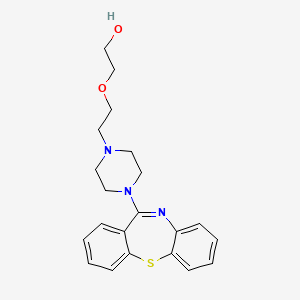D0462 | quetiapine
N
N05AH04 Quetiapine
[N05AH] Diazepines, oxazepines, thiazepines and oxepines
[N05A] ANTIPSYCHOTICS
[N05] PSYCHOLEPTICS
[N] Nervous system
| Toxicity | Dose | Time | Species | Model | Method | Action | Positive criterion | Reference |
|---|---|---|---|---|---|---|---|---|
| ELECTRON TRANSPORT CHAIN | rat | isolated liver mitochondria | decrease | 23 | ||||
| Target | Dose | Time | Species | Model | Method | Action | Positive criterion | Reference |
|---|---|---|---|---|---|---|---|---|
| NADH:ubiquinone reductase | rat | isolated liver mitochondria | inhibitor | 23 | ||||
| Pictogram | Signal | Statements | Precautionary Statement Codes |
|---|---|---|---|
   |
Danger |
Aggregated GHS information provided by 2 companies from 2 notifications to the ECHA C&L Inventory. Each notification may be associated with multiple companies. H302 (100%): Harmful if swallowed [Warning Acute toxicity, oral] H318 (50%): Causes serious eye damage [Danger Serious eye damage/eye irritation] H335 (50%): May cause respiratory irritation [Warning Specific target organ toxicity, single exposure Respiratory tract irritation] H400 (50%): Very toxic to aquatic life [Warning Hazardous to the aquatic environment, acute hazard] H412 (50%): Harmful to aquatic life with long lasting effects [Hazardous to the aquatic environment, long-term hazard] Information may vary between notifications depending on impurities, additives, and other factors. The percentage value in parenthesis indicates the notified classification ratio from companies that provide hazard codes. Only hazard codes with percentage values above 10% are shown. |
P261, P264, P270, P271, P273, P280, P301+P312, P304+P340, P305+P351+P338, P310, P312, P330, P391, P403+P233, P405, and P501; (The corresponding statement to each P-code can be found at the GHS Classification page.) |
   |
Danger |
H225: Highly Flammable liquid and vapor [Danger Flammable liquids] H301: Toxic if swallowed [Danger Acute toxicity, oral] H311: Toxic in contact with skin [Danger Acute toxicity, dermal] H331: Toxic if inhaled [Danger Acute toxicity, inhalation] H370: Causes damage to organs [Danger Specific target organ toxicity, single exposure] H402: Harmful to aquatic life [Hazardous to the aquatic environment, acute hazard] H412: Harmful to aquatic life with long lasting effects [Hazardous to the aquatic environment, long-term hazard] |
P210, P233, P240, P241, P242, P243, P260, P261, P264, P270, P271, P273, P280, P301+P310, P302+P352, P303+P361+P353, P304+P340, P307+P311, P311, P312, P321, P322, P330, P361, P363, P370+P378, P403+P233, P403+P235, P405, and P501; (The corresponding statement to each P-code can be found at the GHS Classification page.) |
| (E)-2-(2-(4-(Dibenzo[b,f][1,4]thiazepin-11-yl)piperazin-1-yl)ethoxy)ethanol | 11-[4-[2-(2-Hydroxyethoxy)ethyl]-1-piperazinyl]dibenzo[b,f][1,4]thiazepine | 111974-69-7 |
| 2-(2-(4-(Dibenzo[b,f][1,4]thiazepin-11-yl)piperazin-1-yl)ethoxy)ethanol | 2-(2-(4-(dibenzo[b,f][1,4]thiazepin-11-yl)piperazin-1-yl)ethoxy)ethan-1-ol | 2-(2-(4-Dibenzo(b,f)(1,4)thiazepin-11-yl-1-piperazinyl)ethoxy)ethanol |
| 2-(2-(4-dibenzo[b,f]-[1,4]thiazepine-11-yl-1-piperazinyl)ethoxy)ethanol | 2-(2-(4-dibenzo[b,f][1,4] thiazepine-11-yl-1-piperazinyl)ethoxy)ethanol | 2-[2-(4-Dibenzo[b,f][1,4]thiazepin-11-yl-1-piperazinyl)ethoxy]ethanol |
| 2-[2-(4-benzo[b][1,5]benzothiazepin-6-ylpiperazin-1-yl)ethoxy]ethanol | 2-[2-(4-dibenzo[b,f][1,4]thiazepin-11-ylpiperazin-1-yl)ethoxy]ethanol | 2-[2-(4-{2-thia-9-azatricyclo[9.4.0.0^{3,8}]pentadeca-1(11),3(8),4,6,9,12,14-heptaen-10-yl}piperazin-1-yl)ethoxy]ethan-1-ol |
| 2-{2-[4-(dibenzo[b,f][1,4]thiazepin-11-yl)piperazin-1-yl]ethoxy}ethanol | 2-{[2-(4-dibenzo[b,f][1,4]thiazepin-11-ylpiperazin-1-yl)ethyl]oxy}ethanol | 4769-EP2272537A2 |
| 4769-EP2272841A1 | 4769-EP2275420A1 | 4769-EP2298731A1 |
| 4769-EP2301936A1 | 4769-EP2308867A2 | 4769-EP2308870A2 |
| 74Q697 | AB00640033-09 | AB00640033-10 |
| AB00640033_11 | AB00640033_12 | AKOS003588973 |
| API0004010 | AS-35258 | BBL029071 |
| BCP23508 | BDBM50095890 | BGL0JSY5SI |
| BIDD:GT0279 | BRD-K68867920-001-05-2 | C07397 |
| C21H25N3O2S | CAS-111974-69-7 | CCG-213347 |
| CHEBI:8707 | CHEMBL716 | CS-1171 |
| CTK8F1296 | Co-Quetiapine | D08456 |
| DB01224 | DSSTox_CID_3546 | DSSTox_GSID_23546 |
| DSSTox_RID_77073 | DTXSID9023546 | ETH065 |
| Ethanol, 2-(2-(4-dibenzo(b,f)(1,4)thiazepin-11-yl-1-piperazinyl)ethoxy)- | Ethanol, 2-[2-(4-dibenzo[b,f][1,4]thiazepin-11-yl-1-piperazinyl)ethoxy]- | FK949E |
| FT-0658790 | GTPL50 | HMS2093K06 |
| HMS2231O11 | HMS3372B05 | HMS3744E21 |
| HSDB 7557 | HY-14544 | InChI=1/C21H25N3O2S/c25-14-16-26-15-13-23-9-11-24(12-10-23)21-17-5-1-3-7-19(17)27-20-8-4-2-6-18(20)22-21/h1-8,25H,9-16H2; |
| L001200 | LS-172170 | M872 |
| MLS001165710 | MLS001195658 | MRF-0000010 |
| NCGC00095911-01 | NCGC00095911-03 | NCGC00095911-04 |
| NCGC00095911-06 | NSC-758918 | NSC758918 |
| Norsic (TN) | Pharmakon1600-01505187 | Q408535 |
| Quetiapin | Quetiapine (INN) | Quetiapine [INN:BAN] |
| Quetiapine fumarate | RT-015180 | SBI-0206776.P001 |
| SC-19077 | SCHEMBL7932 | SMR000550491 |
| SPECTRUM1505187 | SR-01000759335 | SR-01000759335-5 |
| SR-01000759335-7 | STL373578 | Seroquel |
| Seroquel (Fumarate) | Tox21_111537 | Tox21_111537_1 |
| UNII-BGL0JSY5SI | URKOMYMAXPYINW-UHFFFAOYSA- | URKOMYMAXPYINW-UHFFFAOYSA-N |
| W-5151 | ZINC19632628 | ZM-204636 |
| quetiapina | quetiapine | quetiapinum |
| s5741 |

